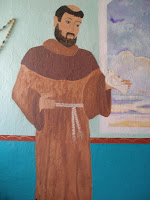 |
| Sample letter to Sen. Jeff Bingaman (Holy Rosary Parish) |
One of the tools that Bread for the World provides for advocates to introduce the Offering of Letters to their congregations is a handy
powerpoint, along with
tips and suggestions on how to best use this great resource.
An Offering of Letters is also effective when you get an endorsement from the pulpit, especially a thumbs up from the pastor. In fact, having the pastor preach on the topic of the Offering of Letters would be ideal, especially if the theme fits nicely with the scripture readings for that Sunday (or weekend).
But it doesn't have to be the pastor the folks in the pew to write letters. Dedicated lay persons can also perform this task. This is exactly what Crish Tippit and Rita Harris did at All Saints Lutheran Church in Albuquerque did when offered the opportunity to do a presentation to the congregation. They decided to provide the information with a simple, but very effective, skit. (Incidentally, the OL committee at All Saints Lutheran decided to focus on the mini campaign dealing with Tax Credits for Low-Income Families. The 75 letters that came from the church's OL were sent primarily to Sen. Jeff Bingaman, who sits on the Senate Finance Committee and has a key role in legislation to renew these important tax credits).
Here is the script for the skit:
Crish: sh: Hey Rita. Are you
going in Fellowship Hall to write a letter to Senator Bingaman? It’s
Offering of Letters day.
Rita: Uh….I really have a lot to do right now. I was going straight
home.
C: Come on, Rita. This is important. How long is it going to take you to
write one letter? We even have a sample letter with talking points if you want to use it.
R: Well…I guess I could. I really haven’t been paying much attention. What are we writing about this year?
C: Senator Bingaman is on the Finance Committee. We want him to
support making the Earned Income Tax Credit (EITC) and the Child Tax
Credit (CTC) permanent. Those programs are expiring this year and we
want to be sure and protect working poor people who don’t make enough to
support their families. These tax credits really help. For instance, in
2010 the EITC lifted 5.4 million people out of poverty—including 3
million children.
R: Wow. I know a woman who received that tax credit. She was able
to pay for car repair so that she could get to work. Without that extra
money, she would have been stuck. She has all she can do just to feed
her 2 kids.
 |
| Display, Aquinas Newman Center |
C: Exactly. And there are other programs that protect poor and
hungry people that are in danger of being cut. Congress is so worried
about cutting the budget that they seem willing to do it on the backs of
the poor.
R: What kind of programs?
C: Two that I know of are the Food Stamp program (SNAP) and
WIC—Women and Infant Children. These are funded through the Farm Bill
which is also up for renewal this year. Over 40 million Americans used
Food Stamps last year. These are mainly people living below the poverty
line. And WIC served more than 9 million women and children in 2010. We
should urge Congress to continue these programs.
R: I’m amazed that there are that many people on these programs.
What I mean is I’m amazed that there are so many poor and hungry
citizens in this country. It’s a shame.
C: One thing we know. These programs really work. Even through all the
financial problems and unemployment of the past 3 years, these programs
have kept household hunger rates from increasing further.
R: Well, I’ll definitely stay and write a letter. In fact, I’ll
see if my 2 kids in Sunday School can write one, too. It won’t hurt them
to be aware of how many people in this country go hungry.
C: Thanks, Rita. And you can enjoy a cup of coffee and some snacks
while you are writing.
































